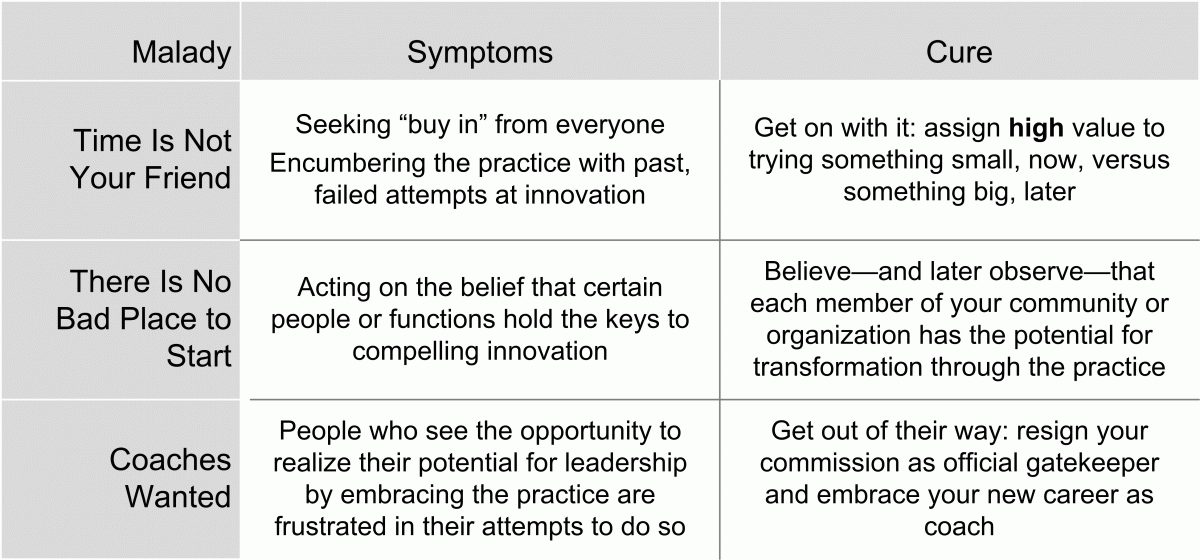Persistence is a blade with two sharp edges.
We deem people who persist in pursuing what we see as a worthwhile cause as noble. Committed. Persistence in this light qualifies one for praise.
We deem others who persist in pursuing what we see as a spurious cause as misguided. Quixotic. Persistence in this light qualifies one for a cell.
The practice of collaborative innovation can rest on the green, rolling hillsides of the former camp. People who practice collaborative innovation seek to engage more deeply and more meaningfully with members of their community and their organization. They see value in the gifts that others bring to the table. They see possibilities for effecting authentic transformation in their communities and organizations by helping their peers realize their potential for leadership in surfacing and collaborating on ideas. They see, too, the possibilities for transformation in the openness and transparency that the Digital Age brings.
People may perceive value in the practice. They may, too, perceive pursuing the practice as quixotic if its adherents fail to make headway in short order.
In this article, I share approaches that, in my work with clients, I have observed them apply that increase the likelihood that their practice persists in their community and organization.
Time Is Not Your Friend
When I first began to work with people on developing their practice of collaborative innovation, I believed that we would find that lack of engagement—that is, we throw a party and nobody comes—would prove to be the most reliably lethal killer of their program.
I was wrong.
Instead, I observed that time, in its inexorable passage, enjoyed enormous power in its ability to quietly steal the life from the practice before its advocates could promulgate it.
Time escaped them in many ways. One client spent time convincing themselves over and over again that exploring the practice qualified as a worthwhile endeavor. They sought “buy in” from every corner. The possibility of authentic transformation paralyzed them. Another client spent time attempting to incorporate the remnants of an antediluvian suggestion box into their Digital Age practice.
I was surprised and ultimately disappointed to find that, in both cases, the passage of time dulled the memories of why the practice held such promise. The original set of practitioners abandoned the work.
Lesson learned: get on with it. Move forward. Treat the practice as an innovation in its own right: something people must trial and experience before they can be expected to commit to it. Stakeholders are in truth steak holders: they expect meat. Give the carnivores one savory bite at a time.
Here Be Fertile Ground
I had first assumed that certain parts of the community or organization would enjoy the most fertile ground in terms of yielding the most plentiful number of compelling, transformative ideas. Product development and brand management came to mind as the usual, likely suspects.
I was wrong.
My experience has led to two epiphanies. First, the people who have historically held the innovation charter for their organization can become suddenly risk averse and suffer a debilitating paralysis when contemplating the idea of engaging the larger community in the practice they view as their province. Believing that good ideas can come from anywhere is one matter. Acting on that belief is another matter, altogether. Second, the potential for transformation in any part of the community and organization is limited only by the potential for leadership that the people living and working there possess. Some of the most compelling instances of authentic, powerful transformation that I have observed amongst the clients that I serve have come from seemingly mundane, transactional oriented areas such as the groups that answer the phones, that process the mail, and that manage project schedules for internal stakeholders.
Lesson learned: declare no ground as barren as you plan your first foray with the practice. You may find as I did: any group that engages a community’s stakeholders or an organization’s clients directly will have a wonderfully realistic and insightful perspective on where matters stand and how matters might be improved, if only people would engage on the questions that matter. Further, relative to my first lesson learned, you may find—as I did—that these front-line groups are mercifully unencumbered by preconceived notions of what innovation is or is not. Assign extra points to groups that have a track record of getting things done.
Coaches Wanted
The practice that clients pursue within their community or organization conforms to that entity’s culture and, by extension, structure.
Clients that value federated structures, in which decision making is delegated down to where the work with stakeholders is done, tend to disseminate the practice of collaborative innovation, too. Practically speaking, taking this approach means that people at the level of a department, work group, or program feel open to posing their own critical business questions, forming their own communities, and applying the practice in the ways that make sense to them. By contrast, clients whose culture assigns a high value to conceiving and executing on campaigns or large-scale initiatives (e.g., engineering firms in capital intensive businesses) tend to roll out their practice in similar fashion. The initiative is meticulously planned and managed. The people who pursue the practice tie its success to their career prospects. The stakes seem high.
Lesson learned: whereas both approaches—bottoms up or top down—have merit, the bottoms up approach offers the advantage of getting the practice in more hands, sooner, at lower perceived risk. And, some of those hands will make the practice their own, helping to guarantee its long-term future in the community or organization.
In the federated environment, the lead practitioner more readily takes on the role of coach, helping their peers perfect their own practice as they pursue the work with their communities.
Parting Thoughts
We have reached a point in time where people, at an intellectual level, can appreciate the need to recast the nature of our engagements within our communities and in our organizations. The Digital Age, in offering openness and transparency, demands in turn speed. Responsiveness. The world moves faster than traditional, top-down approaches to governance can accommodate.
At the same time, people who see the value in bringing the practice of collaborative innovation to their communities and organizations as a way forward must nevertheless play their hand wisely if the practice is to persist in their particular, peculiar set of circumstances.
My findings? Do not waste time. Get on with it. Start somewhere. Anywhere can be fertile ground for the practice. And, explore the possibilities of coaching, not prescribing. Prescribing is overhead. The Digital Age has a way of stripping away waste in all its manifestations, including overhead that you bring with you in your practice.
The following, closing figure summarizes the above thinking (figure1).
Figure 1: suggested remedies for some of the maladies that prevent the practice from proliferating
By Doug Collins
About the author:
 Doug Collins is an Innovation Architect who has specialized in the fuzzy front end of innovation for over 15 years. He has served a variety of roles in helping organizations navigate the fuzzy front end by creating forums, venues, and approaches where the group can convene to explore the critical question. As an author, Doug explores the critical questions relating to innovation in his book Innovation Architecture, Practical Approaches to Theory, Collaboration and Implementation. The book offers a blueprint for collaborative innovation. His bi-weekly column appears in the publication Innovation Management.
Doug Collins is an Innovation Architect who has specialized in the fuzzy front end of innovation for over 15 years. He has served a variety of roles in helping organizations navigate the fuzzy front end by creating forums, venues, and approaches where the group can convene to explore the critical question. As an author, Doug explores the critical questions relating to innovation in his book Innovation Architecture, Practical Approaches to Theory, Collaboration and Implementation. The book offers a blueprint for collaborative innovation. His bi-weekly column appears in the publication Innovation Management.








